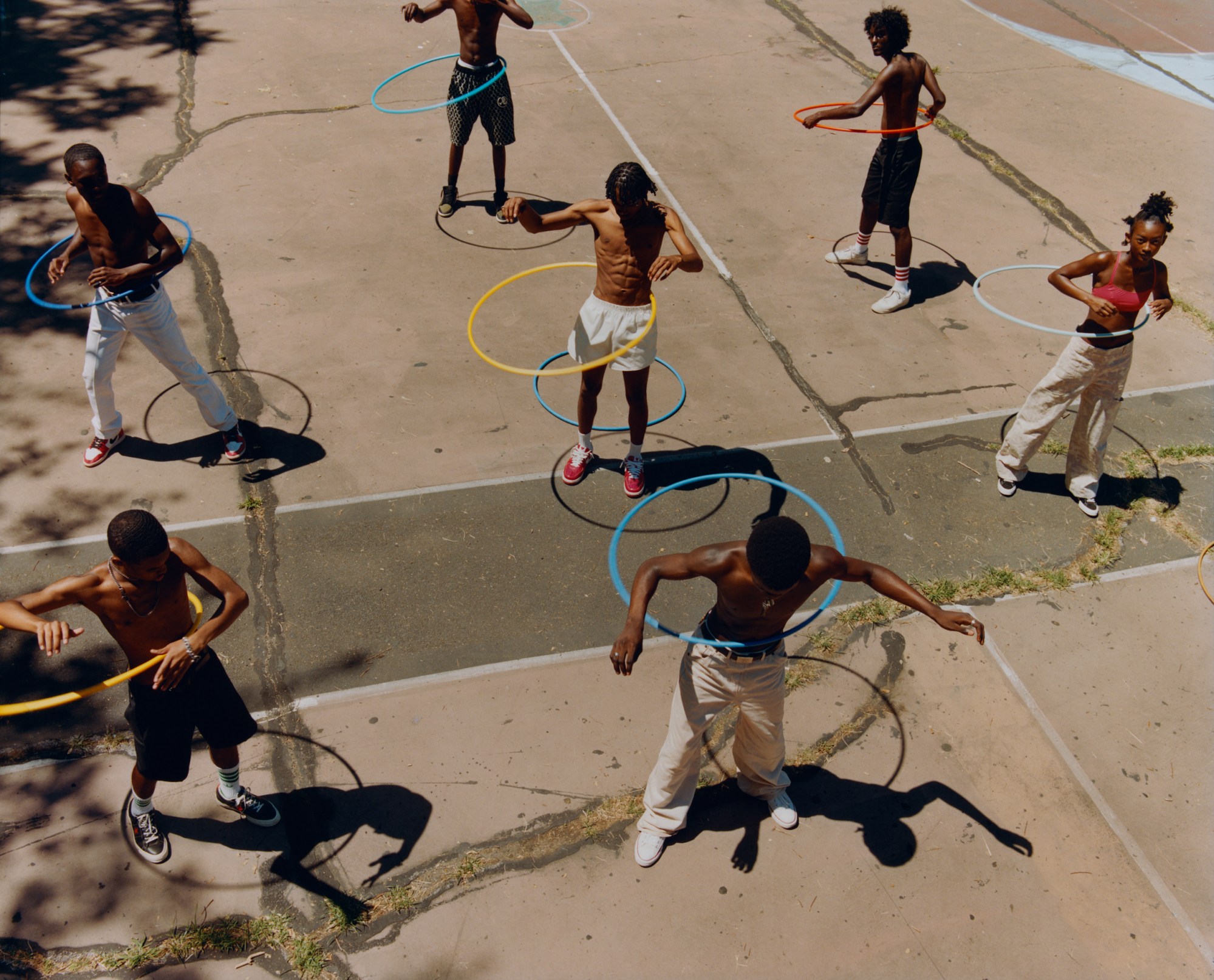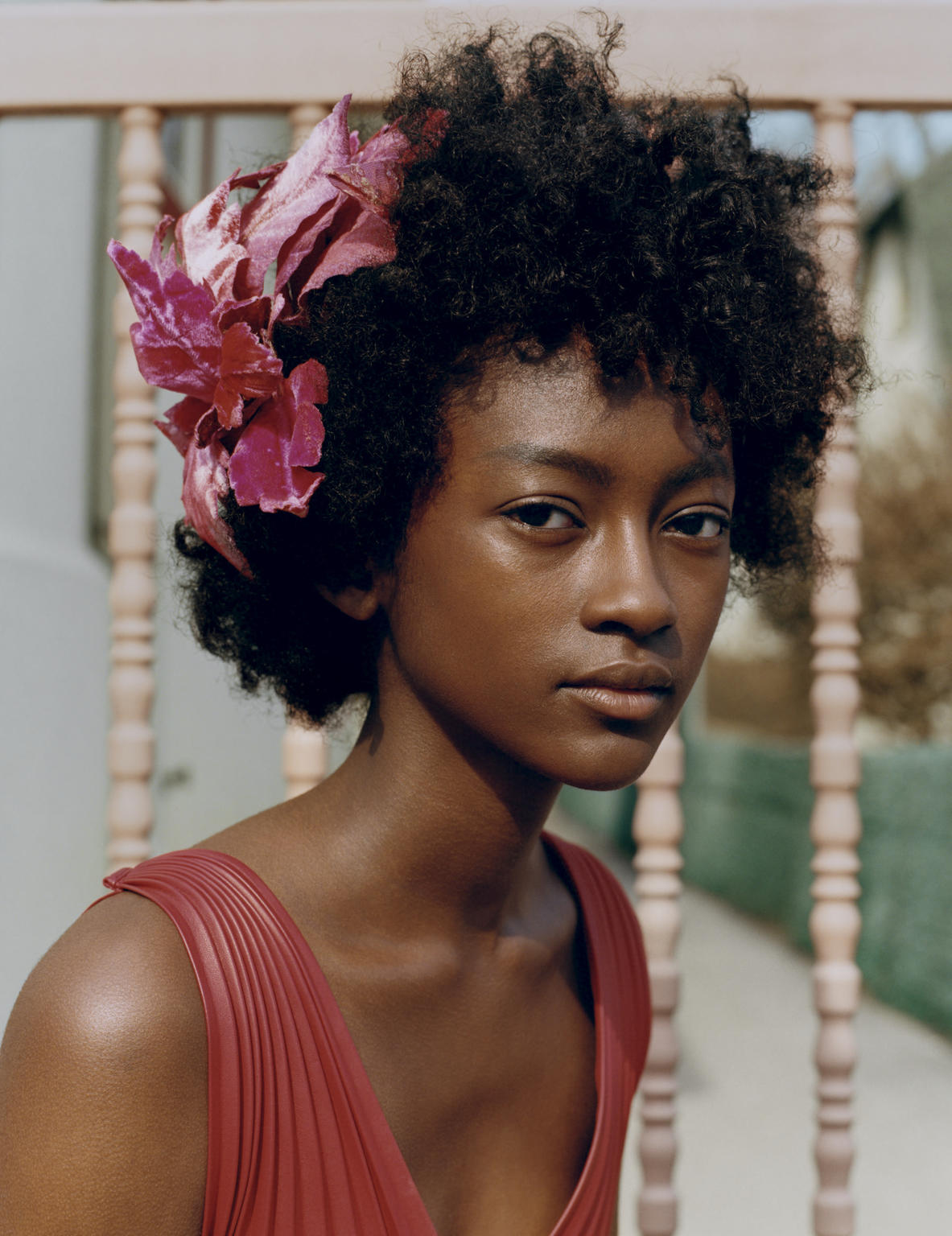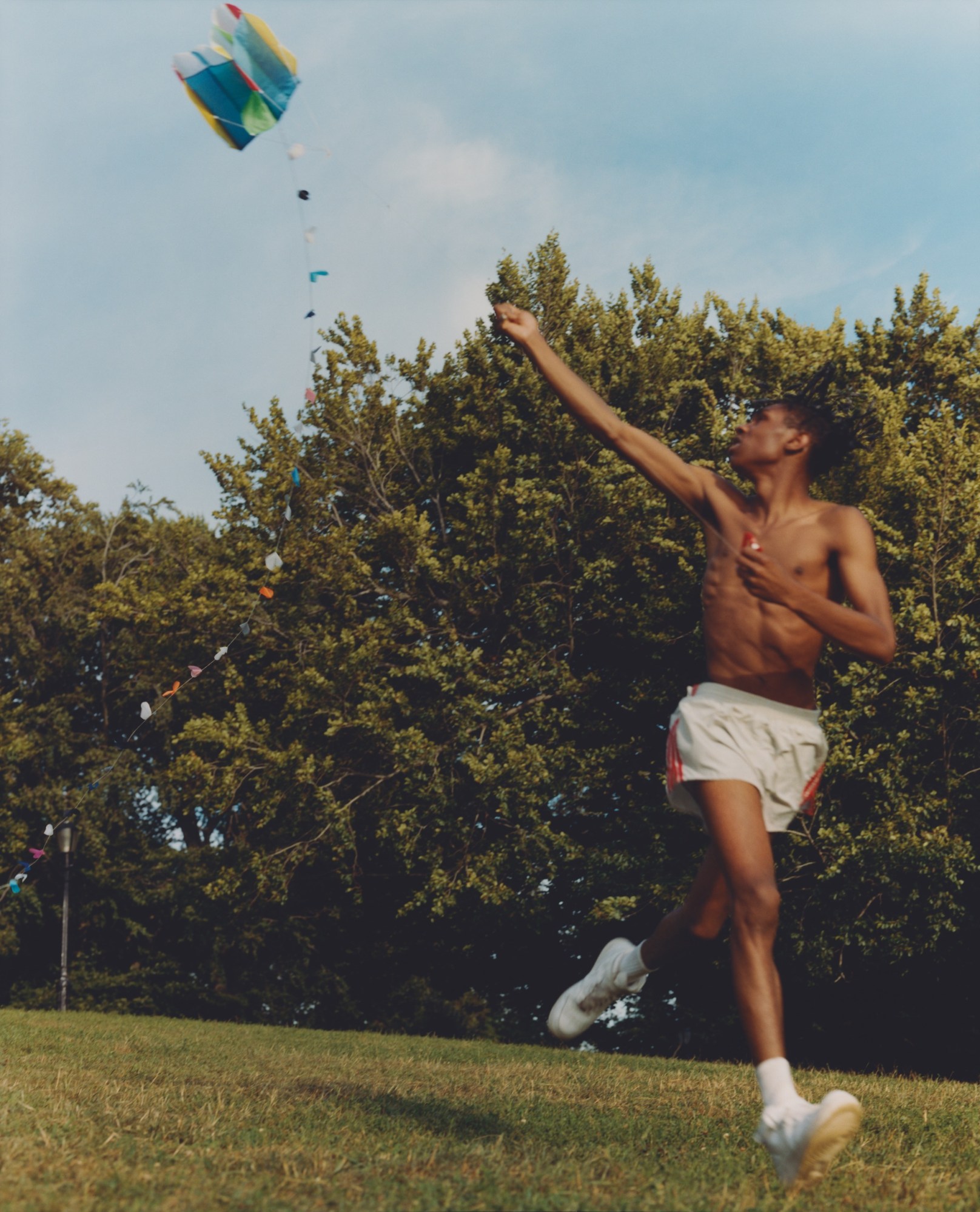This past week, photographer and frequent i-D collaborator Tyler Mitchell opened his anticipated exhibition “I Can Make You Feel Good.” With his first solo show in the US, the 25-year-old photographer adds new work centering around black identity, expanding on the showcase of the same name that opened at Amsterdam’s Foam museum last year. “With this project I’m trying to explain these ideas that I’m working through which are very autobiographical and sometimes political,” he explains. “Dealing with racial and gender identity, through dress in a museum space.”
Included in the show, which is on display at ICP’s new home in New York’s Lower East Side until May 18, are two videos: “Idyllic Space” and “Chasing Pink, Found Red,” both comprised of a series of scenes shot with Mitchell’s signature natural light and vibrant hues and featuring black youths engaged in relaxed and carefree activities. The two films serve to remind the viewer that seemingly mundane activities many take for granted have historically been denied to black people, both in experience and portrayal.
The immersive exhibit also features an installation of Mitchell’s personal and commissioned photographs printed on various types of fabric, including expensive silks, linens, cotton bed sheets, pillow cases and kitchen towels. Viewers are invited to walk amongst the images, which are hung from a laundry line that runs the length of the museum’s 60-foot hallway. “My photos already feature a lot of fabrics, both practically as backdrops and as allusions to laundry lines as a symbol for the working black domestic body — and also as reference to Roy DeCarava and Gordon Parks’ pictures of Harlem families,” he explains. “A lot of these images people have maybe seen before on Instagram or in a magazine, but now they’re really recontextualized.”

To find out more about the exhibit, representation, and documenting the black body, i-D caught up with Mitchell.
Where did the idea for the laundry line come from?
I wanted to do it as a way of returning. You see the laundry line and you really know what that is. It puts you in a time and place. You can picture the family that has their towels and their bed sheets across an awning or building. I’ve always loved that allusion, that metaphor. And then of course Beyoncé made her appearance on the Vogue cover with the fabric billowing in the wind in front of her dress in the Pan-African flag colors. So it’s always been a motif in my work and I wanted to return to a lot of these photographs — both recontextualize them by printing them on fabrics and also installing them in this poetic and literal way.
I’m really happy with it because the images really take on new form. It was truly an experimentation for me and my printer. We dye sublimated the photographs on the fabrics — when you only screen-print them, you lose a lot of color. We had to soak the fabric in these different solutions to really get the colors to come out; they’re still very rich. It’s fun.
And you’ll have some workshops and programming in the space over the duration of the installation?
Yeah that was part of the draw for the show — I wanted to activate both the ICP school and their public programs. We’re hoping to do a film night where I’m going to YouTube DJ a lot of clips, movies and video artworks related to the themes of the visual utopia and black identity. We’re also going to do a food program, and a couple of things to engage the ICP library. When it was in Midtown, I often went and got inspiration from their photo books. Additionally, I want to do a symposium where I’ll invite a lot of artists to come and talk about the themes in the show and beyond. That’s exciting to me — being able to activate this gallery through a lot of my collaborators and people I’m in communication with. And bring kids into the gallery, because I really don’t want my audience to be solely from the fine art community.
Do you approach your commissioned work and your personal projects the same way?
I definitely do. Obviously a commissioned project will be dealt with differently because the client is involved, but otherwise, I don’t approach them differently at all. They’re both using fashion to speak about the black body. With natural light and candy-colored palettes, I’m creating this contrived fantasy world in speaking about black identity. You’ll see both types or work in this installation. The museum adds context for my work. I wouldn’t say I keep these pictures over here for museum shows and those over there for fashion shoots.

How important is casting? Do you have to compromise a lot on that?
I think it’s always a conversation. There are certain projects in my commissioned work that are more loose. You have to know where to pick your battles. I’ve had the extreme fortune of being very gung-ho and pushy on photographing people that reflect myself. That’s maybe for better or for worse. It’s not always the best thing, but I’m interested in speaking about young Black men and women. It’s not even really very diverse. Diversity is aside from the conversation. It’s very autobiographical.
But in the larger sense, you’re diversifying the portfolio of what is out there.
Yeah in a way.
And you say, “for better or for worse,” but I think it’s really important that you’re pushy on the casting. The past five years have been so strong with black creatives really coming through — you look at Telfar and Pyer Moss and yourself. Do you think that institutions are fully recognizing this and structurally changing to reflect it?
I know for sure it’s hard to say. I’m happy because when I think about Pyer Moss and Telfar and myself, or anyone who’s talking about blackness in fashion images or pop culture, A: they have more opportunities at their disposal and at arm’s reach than ever before. And B: I’m happy they’re doing work that tries to make blackness more second nature to our society, rather than something that is obviously fetishized. The artists you just named are dealing with their own identities. And they’re presenting them as beautiful and at the center of the universe; they’re both mainstream proposals.
When I think about this idea of black cultural or artistic production becoming merely a trend that it might come to a stop, I really resent that. These are people who are making beautiful shit, whether you identify it with any culture. I think they’re simply trying to center their experiences which are deeply cultural and deeply black. When I think about institutions shifting structurally or just on the outside, I think about in fashion, the fact that millennials and my generation of people, they represent 350 billion dollars of spending in the fashion industry alone. Nine out of 10 of those want the brand that they invest in to stand for social justice issues. It’s no longer something that brands can ignore. If the vote is where the money is, then you have to change your ways. That gives me hope. I can be a bit of a cynic about people really changing, structures really changing. But when it comes to millennials and my generation, I really believe in us. We’re voting with our dollars. We’re certainly not going to support something that doesn’t support these boundary-pushing thoughts.

Your work is so incredible and important for making a major impact on that shift. You cite McGinley and Larry Clark as your inspiration in the beginning, but their work is often gritty or very fantasy-focused, whereas your work presents a more common existence — which is more effective for what you’re trying to say.
I would say that although my work is very straight-forward, there is still a fantasy in a way. It’s a world that is close to our reality but isn’t quite real. I’m interested in engaging in that. But yeah I definitely agree and see what you’re saying. Like Ryan’s road trips are very extravagant; they’re definitely not daily life.
It’s important that people experience your photos to this end — whether passively in an ad or intentionally seeking them out. The fact that oftentimes you’re not presenting an overt fantasy, you’re using the same sort of idealistic, but still common-life-like American Dream imagery that’s always featured white people.
Yeah, first they’re a fantasy because they’re contrived images. A lot of the storytelling, like the JW Anderson ad with the girls on stilts, that’s elevating them in this very literal and fantastical way. And then you think of the more mundane shots, of these boys with these languid curls and they’re leaned into each other. That does feel real, but it does also subtly question the way that black men believe that they’re allowed to behave. There’s a reality but also the fantasy because I’m dressing up these people and taking them to this specific location and choosing the mood and color and pose to evoke a heightened reality for black folks, a place that’s a bit more free with more leisure time. I think about that leisure time as freedom, as a radical freedom. Leisure time is something that’s been historically denied us. I think about Tamir Rice, a 12-year-old boy who’s playing with a pellet gun in a park and was killed for it.
This stuff I’m photographing is real, but it’s also a fantasy because we’re not psychically allowed to go into these parks and enjoy leisure time. These are behaviors we’ve been self-policing ourselves from. For instance, when I visited my best friend who went to Hampton, a historically black college — I almost went to Howard myself — I visited him on the weekend and the rules were like, no hats indoors, you have to wear a belt at all times, when you’re in certain areas you have to wear a collared shirt. I was like, Are you serious? These are rules that we’ve put in place on ourselves so that we seem presentable according to Western ideas of what presentable looks like. If we don’t present that way, we get killed. That’s what I mean when I say fantasy.



